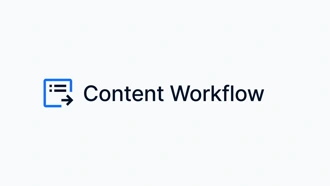The combination of new digital channels, different types of content, and endless audience preferences undoubtedly created new complexities and challenges for many content teams last year.
And, one of the most challenging parts is that 74% of content marketers report grappling with is maintaining the flow of information between teams and departments. Against the backdrop of the never-ending consumer demand for content, a lack of access to centralized tools has led to an environment within many organizations that we at Bynder would commonly term ‘content chaos’.
The result? Lower quality content experiences for your consumers in the marketplace; that is, missed opportunities to impress, engage, and convert your target audiences with your organization’s content.
Implementing effective content lifecycle management is one approach that can ensure that everyone is on the same page. It allows everyone to understand where a piece of content is in the production process.
In this article, we’ll explore what content lifecycle management means, and which tools and processes can help content teams work efficiently.
What is content lifecycle management?
Content lifecycle management refers to all the processes that bring a piece of content from concept to reality.
For example, the lifecycle of a blog post begins from the minute someone generates an idea for it.
Every step the content team subsequently takes to guide that blog post from ideation to publication (and beyond) constitutes content lifecycle management.
Why is content lifecycle management important?
Have you ever been unable to find the digital assets for a webinar or locate the original draft of a published post when it’s time to update it? If the answer is ‘yes’, you might know why content lifecycle management is such a valuable process to have in place.
Content lifecycle management keeps track of digital assets. It’s a management process which helps minimize stress, unnecessary extra budget spend, and the potential time that can be lost hunting down those content assets that are needed ‘ASAP’.
Proper content lifecycle management also increases your content team’s levels of productivity by making the publishing of high-quality content quickly and at scale far easier.
What are the stages of a content lifecycle?
We know what the term ‘lifecycle’ means, but let’s now look at the five key stages of the content lifecycle whilst considering how content team members and marketers can make the most of each stage.
1. Content planning
Content planning is a crucial first stage of the content lifecycle. It lays the foundation for a successful piece of content being created because it takes into consideration the overarching strategy and the needs of your audience.
To make the most of this planning phase, take note of the following tips:
- Identify your business goals: Know your goals upfront — whether it’s about creating brand awareness, gaining trust in the marketplace, or driving conversions — so that you can steer your marketing efforts accordingly.
- Develop a content strategy: Recognize which metrics to measure, which topics to base your content on, and which content roadmap to pitch to stakeholders.
- Invest in audience research: Understanding your audience means knowing their ‘pain points’, which type of content is most relevant to them, and what is likely to resonate best.
- Do keyword research: Keyword research is the foundation of search engine optimized (SEO) content and heavily informs your content planning.
- Start building out an editorial calendar. Keep track of what’s next for your content team by using a reliable tool to capture the content you want to release over the coming month, quarter, or year.
With a solid plan in place, you can confidently kickstart the creation process whilst maintaining a consistent publishing cadence.
2. Content creation
We already know that creating content is a multi-step process. At this point, you’ll need to decide whether to keep all the work in-house or outsource some tasks to freelancers or an agency.
At a high level, the process of content creation should involve all of these steps:
- Preparing a content brief
- Creating the content
- Editing drafted content for grammar, style, messaging, flow, and so on
To make the best out of this phase of content creation:
- Choose content formats that you know will be most effective for your audience (for example, long-form articles and videos over white papers and guides)
- Use a tool that allows you to be collaborative, like Content Workflow by Bynder
- Outsource content creation wisely (i.e. only when needed, it’s within your budget, and only to high-quality contractors)
- Always focus on ‘content quality’ over ‘content quantity’
3. Content publication and distribution
Next up is going live with your content and ensuring that it’s promoted on the right channels for your target audience.
The bulk of the publishing load rests with your chosen content management system (CMS), as well as the obvious factors such as ensuring content is formatted correctly. Additionally, make sure to take advantage of SEO opportunities such as writing strong meta descriptions, choosing an accurate URL slug, and incorporating internal links. These are all conventional tactics, but ticking these boxes can ultimately boost your search engine results page (SERPs) rankings.
How you distribute content depends on how your audience prefers to consume content. For example, you may already know that your audience engages with email newsletters, are most active on social media platforms like LinkedIn and X (formerly known as Twitter), and visit video-sharing platforms like YouTube to look for specific information or conduct product research.
4. Content updates and optimization
Research by Hubspot shows that updating your content every so often and keeping it fresh can result in up to 106% growth in organic traffic. Helpful to bear in mind when you consider that only a certain proportion of your organization’s content will truly be ‘evergreen’.
So, once you’ve published and distributed those newer pieces of content, set a reminder to review it periodically so that you can keep it refreshed and as up-to-date as possible.
In line with this, it’s a great idea to review your website analytics regularly to allow you to identify which items of content might benefit from a review sooner rather than later. For example, turning your attention to higher-performing content first might result in your edits improving the volume of traffic they receive or their conversion rates.
Another example might be turning a more general piece of content into a ‘lead magnet’ by enriching it with new information, statistics, or data — and therefore ‘adding value’.
5. Ongoing content management
Content management refers to the process of creating, collecting, editing, and delivering any form of information on any medium.
Anything can be considered ‘content’ — from images and video to audio, multimedia, and text.
All content comes with a content lifecycle of its own; one that needs to be managed onwards from the ‘creation’ stage to the ‘storage’ or even ‘deletion’ stage.
To keep producing effective content at scale — especially content which needs to be personalized — organizations need a secure and accessible way to organize and store their content.
Not all businesses are currently benefiting from such a system, but a massive four out of five marketers believe that their team performance would increase if their organization went ahead and invested in a centralized Digital Asset Management (DAM) solution to help with their content management.
Regain full control over your content lifecycle with Content Workflow
DAM will indeed make it easier to store your digital media, documents, and assets, but files such as these won’t always be easy to access, review, and update collaboratively without an all-encompassing tool such as Content Workflow by Bynder.
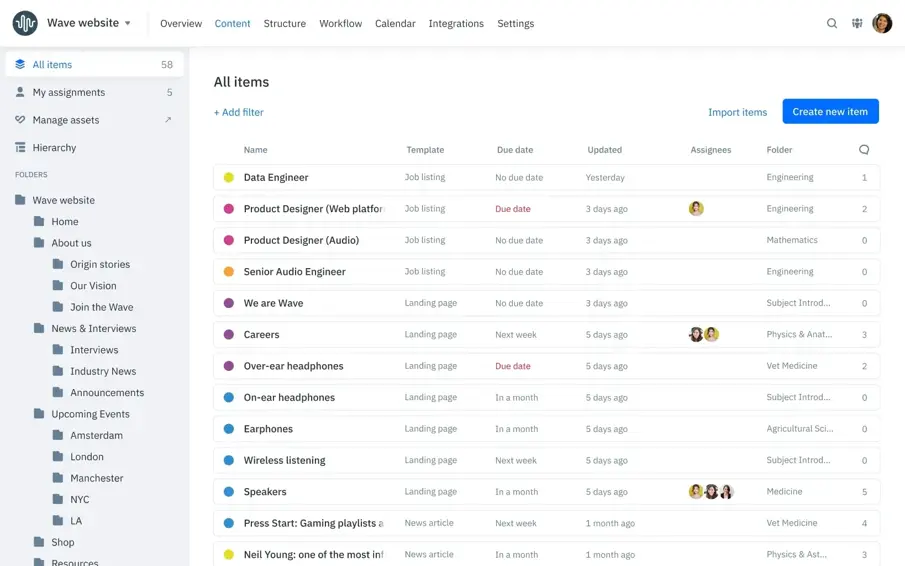
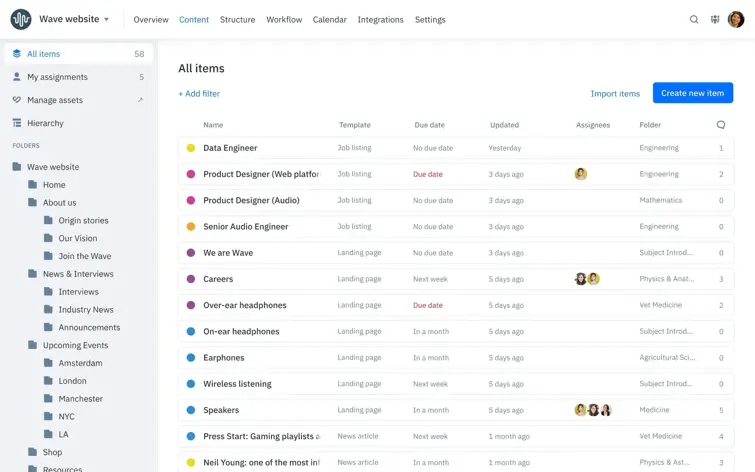
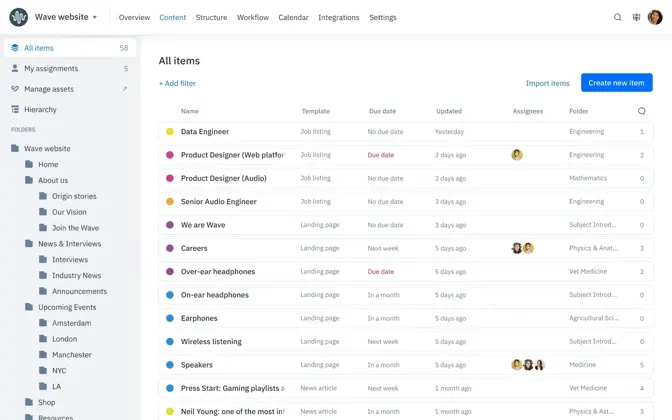
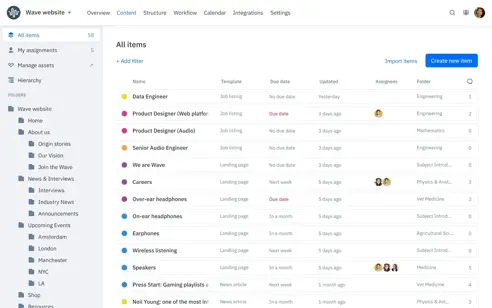
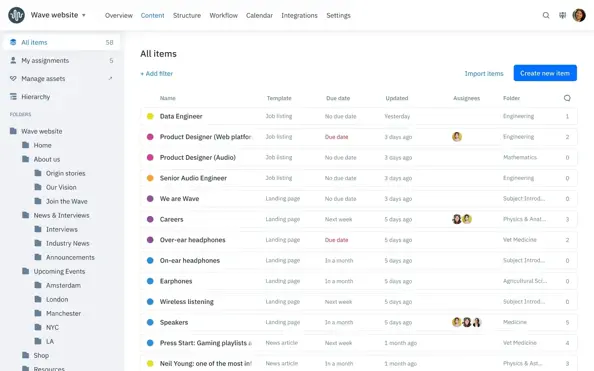 Content Workflow is an all-in-one tool that allows you to maintain control over the content production process
Content Workflow is an all-in-one tool that allows you to maintain control over the content production process
A tool like this provides a strong backbone for executing those five stages of content lifecycle management at your organization, whilst allowing your content team to regain control over the entire content production process.
Our parting words? A content lifecycle that’s managed effectively — and aided by the right tools for the job — will ultimately help unite your internal teams (and any external content stakeholders), save you precious time and resourcing costs, and perhaps most importantly, deliver better content experiences to your consumers.











